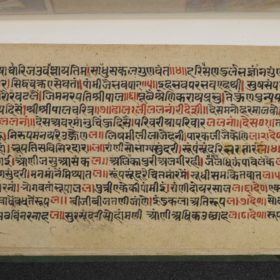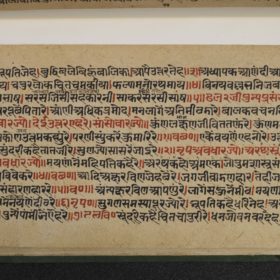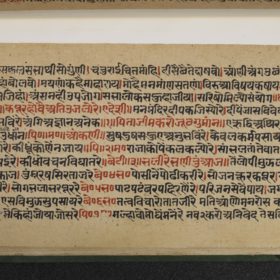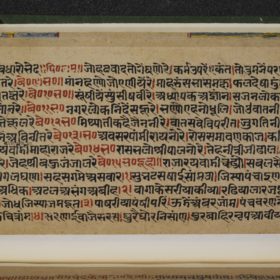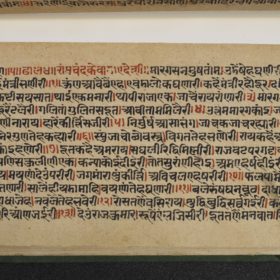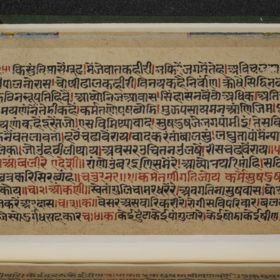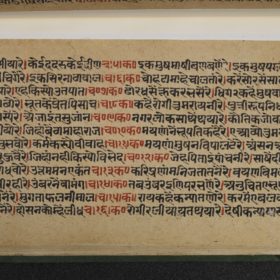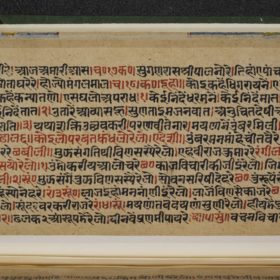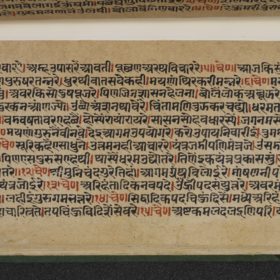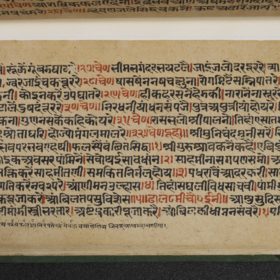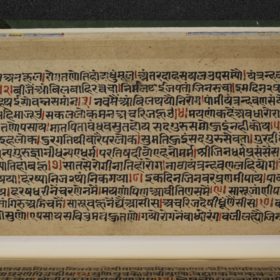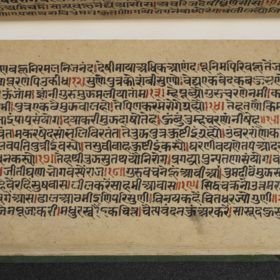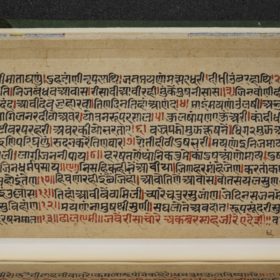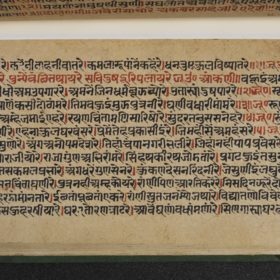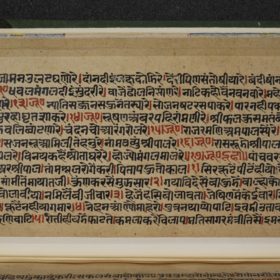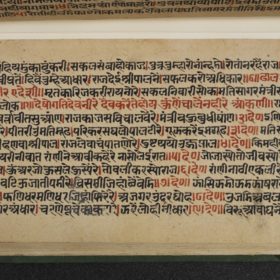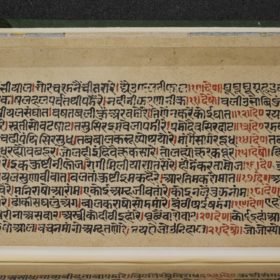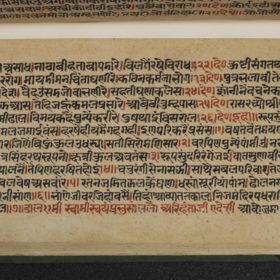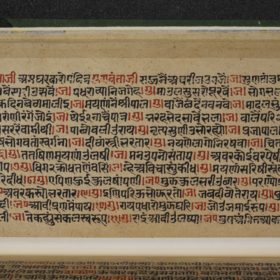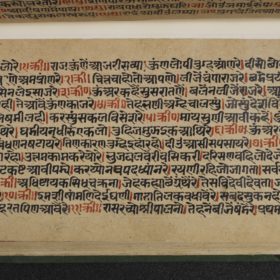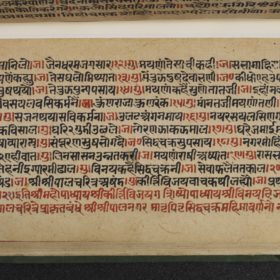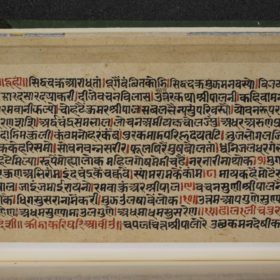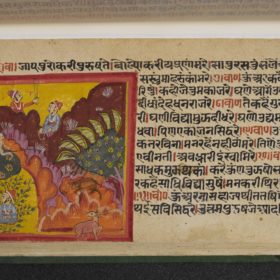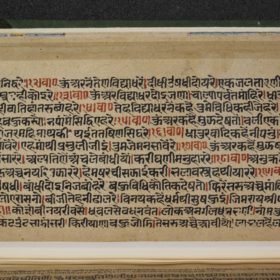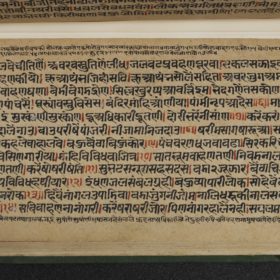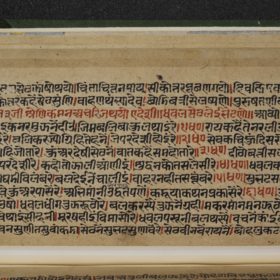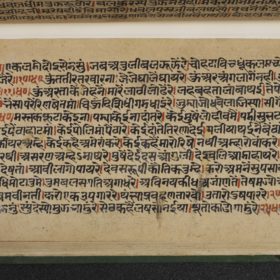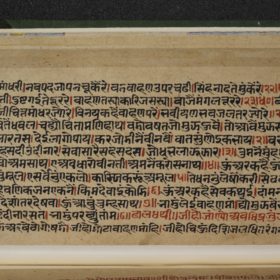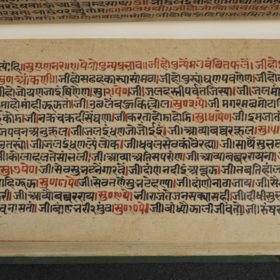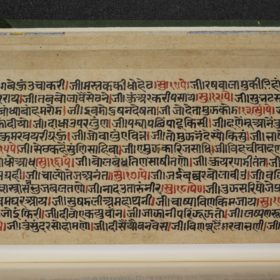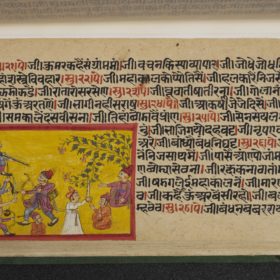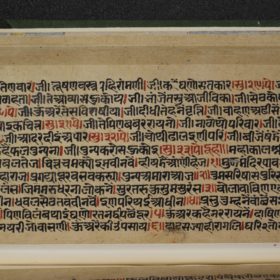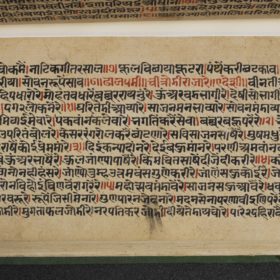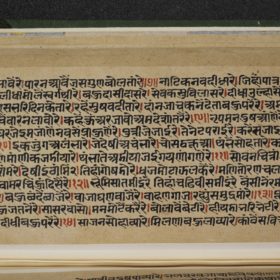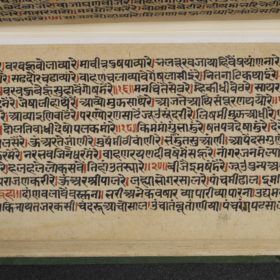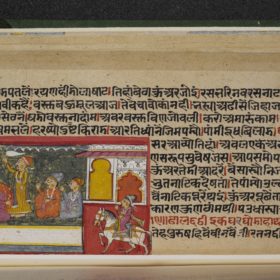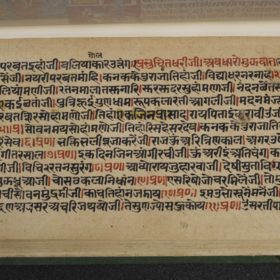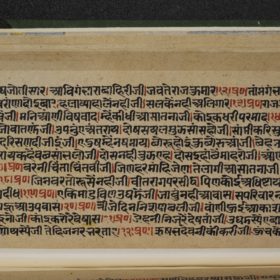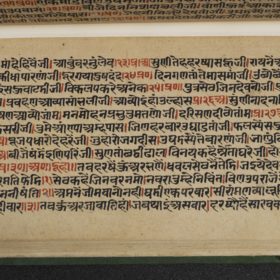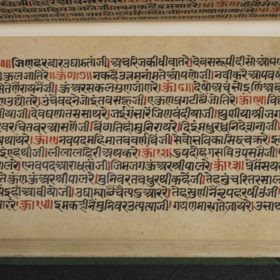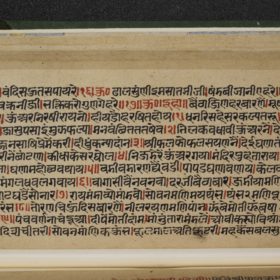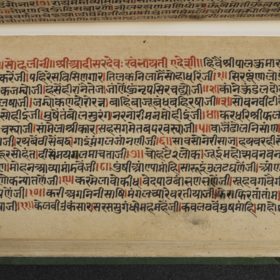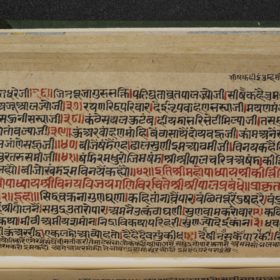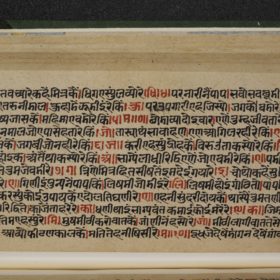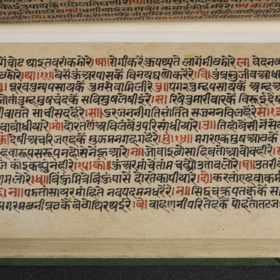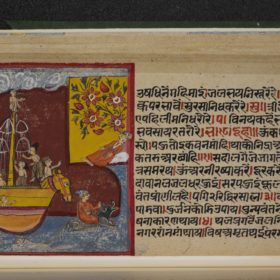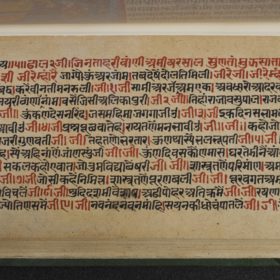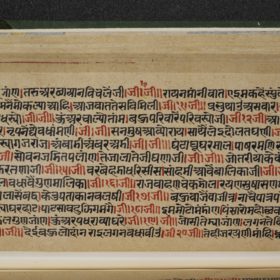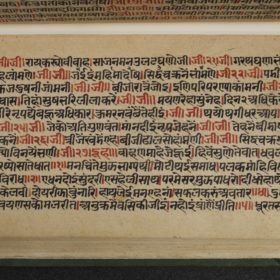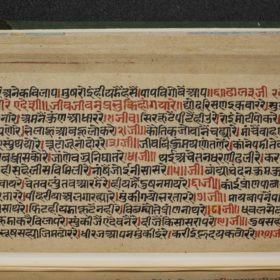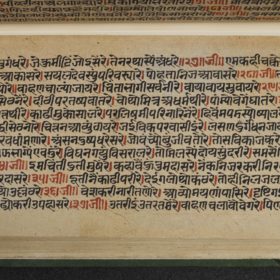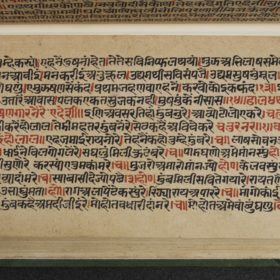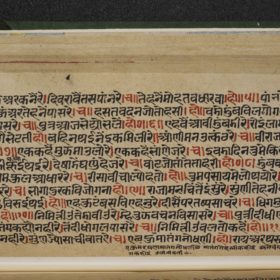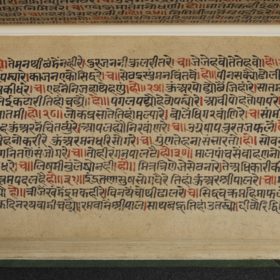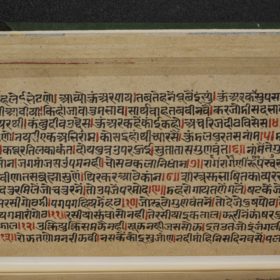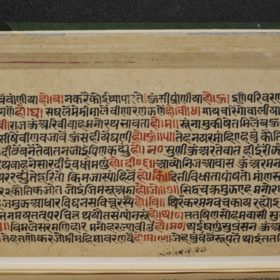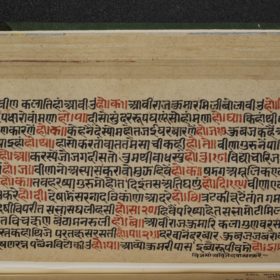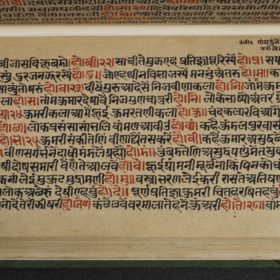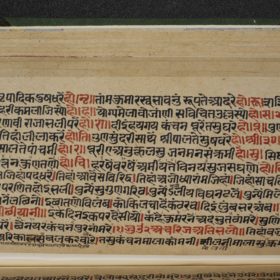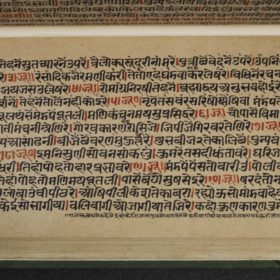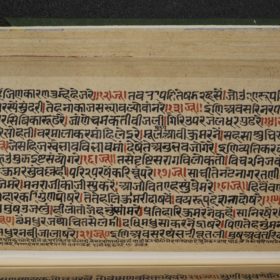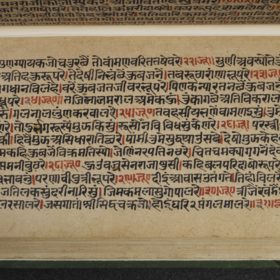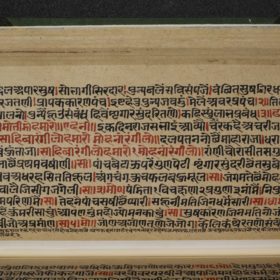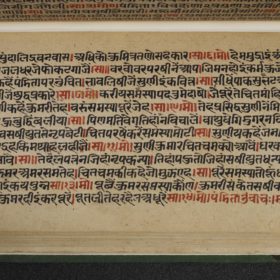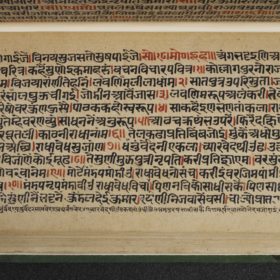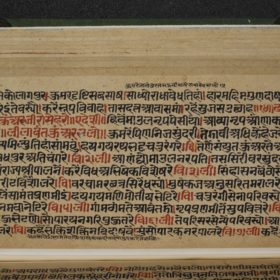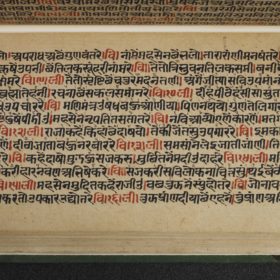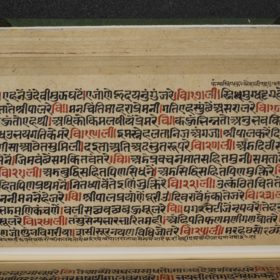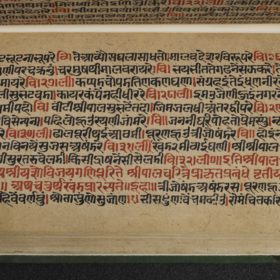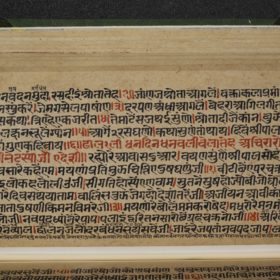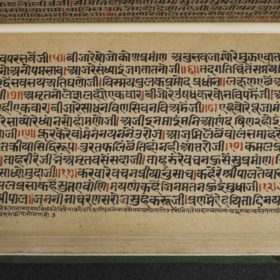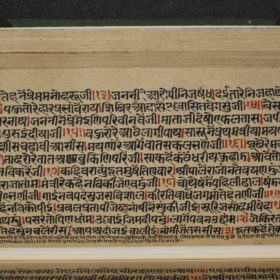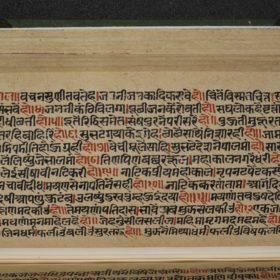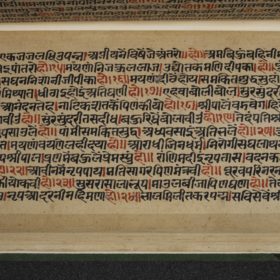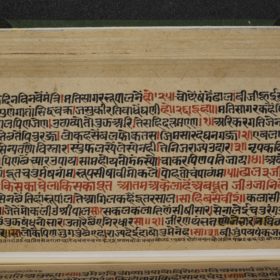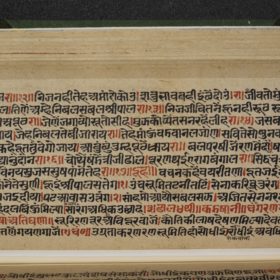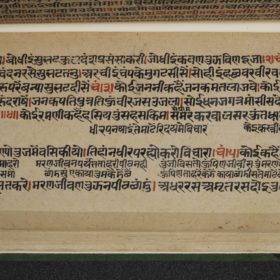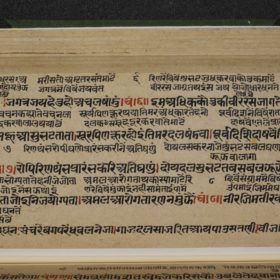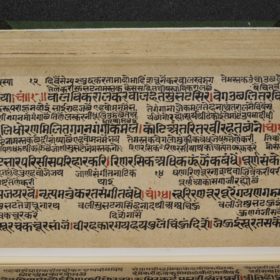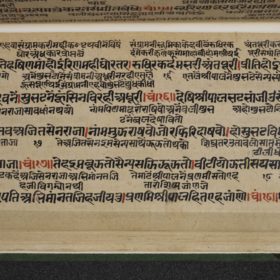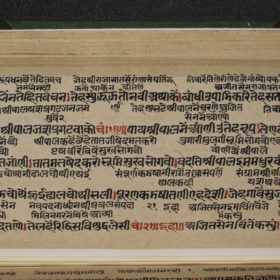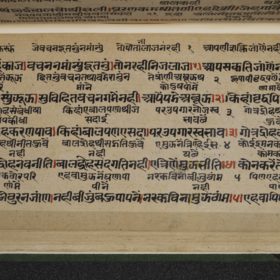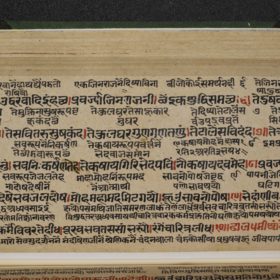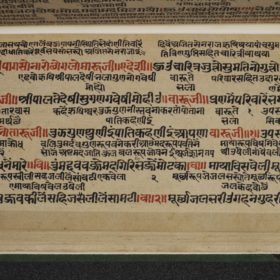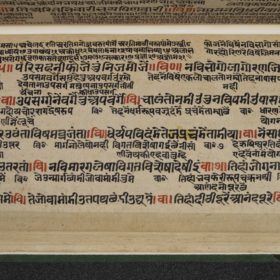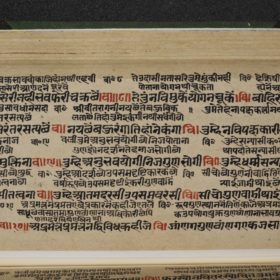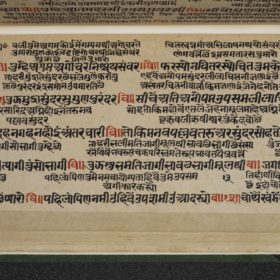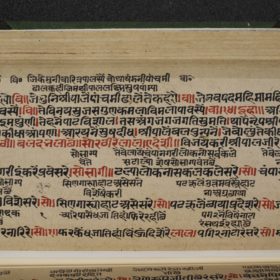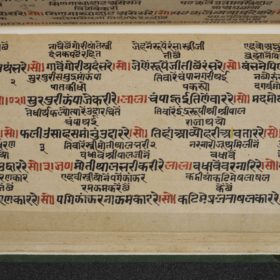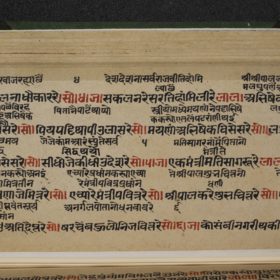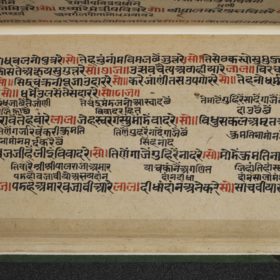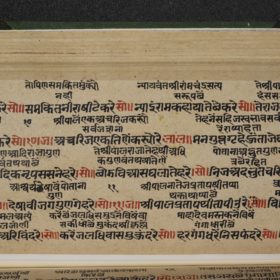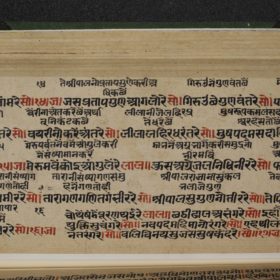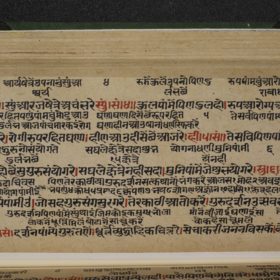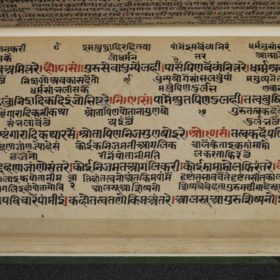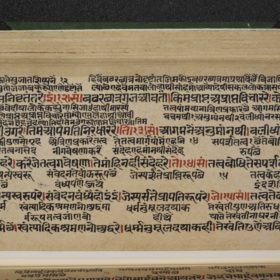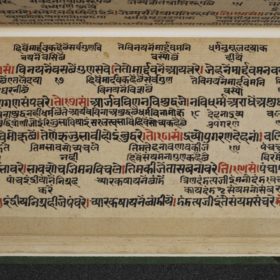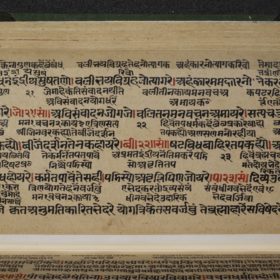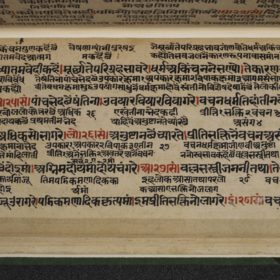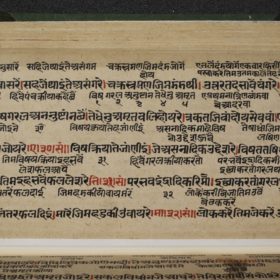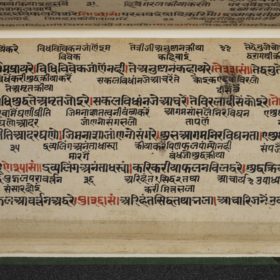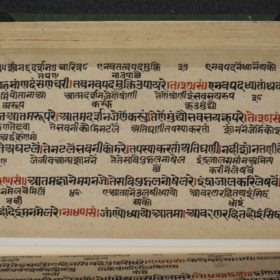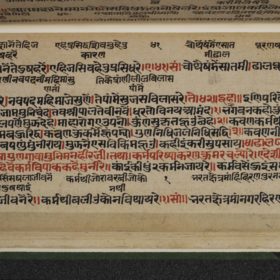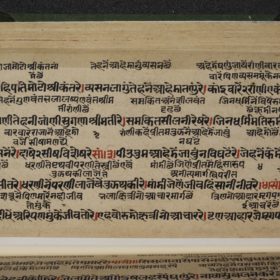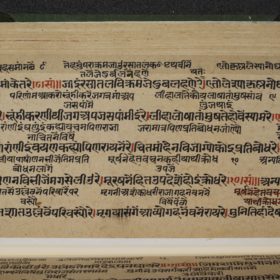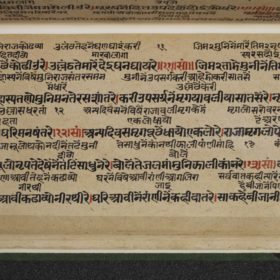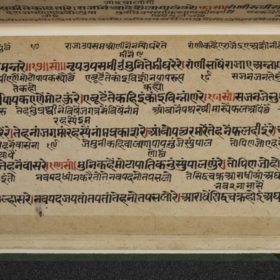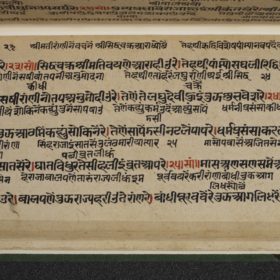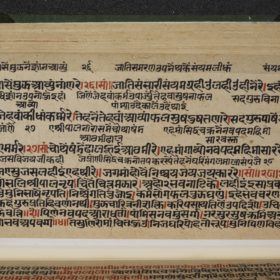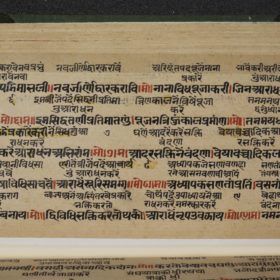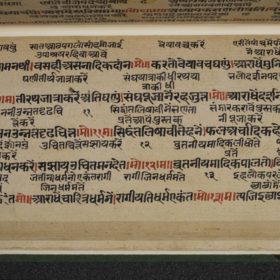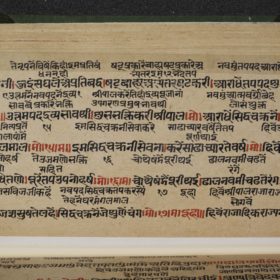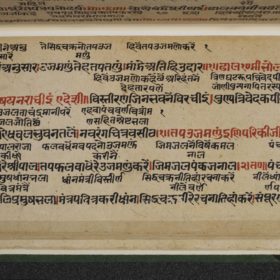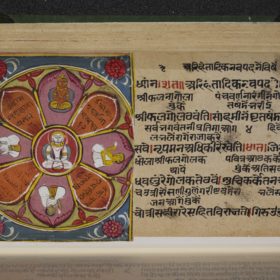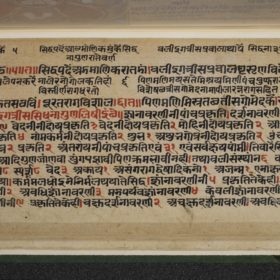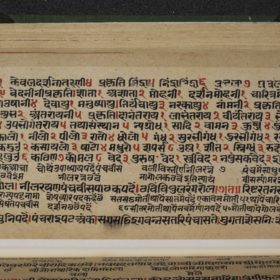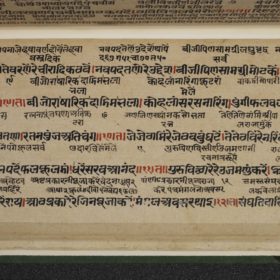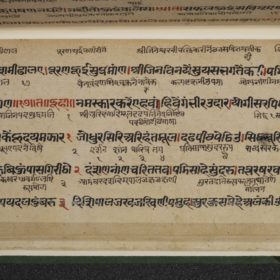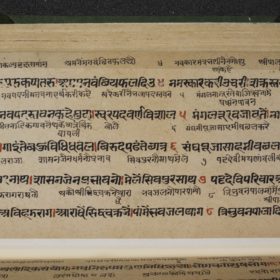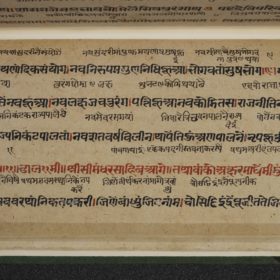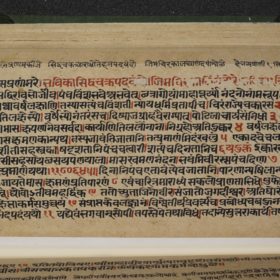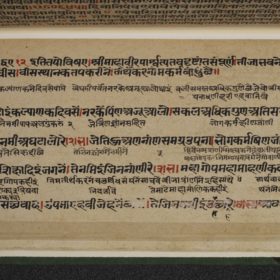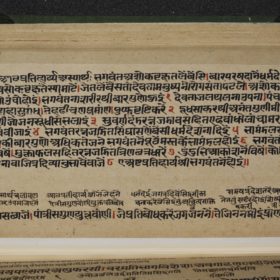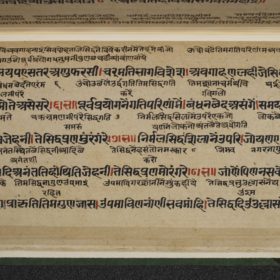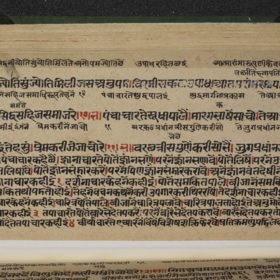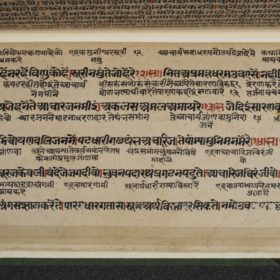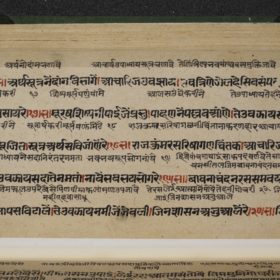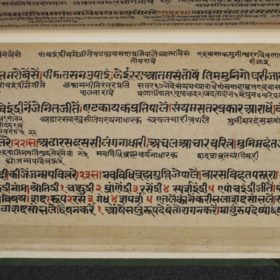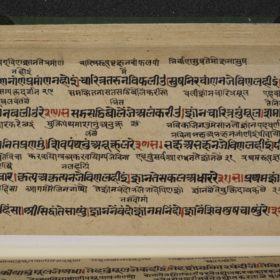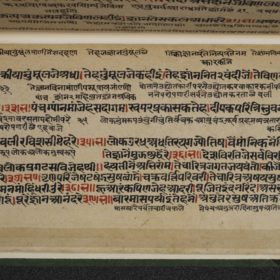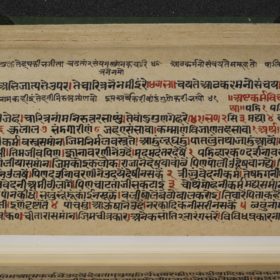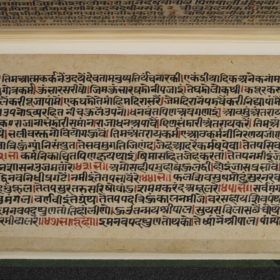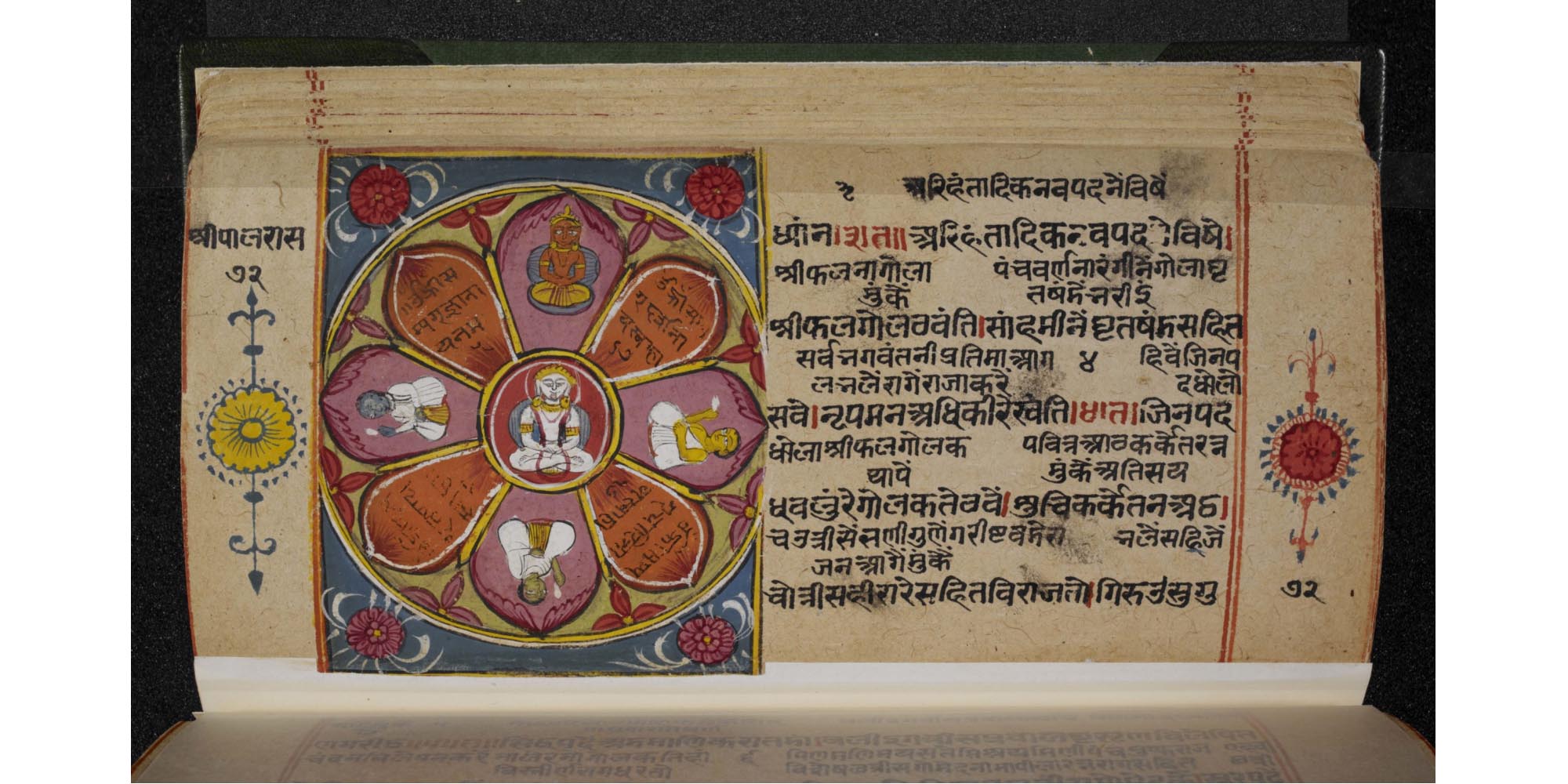
Background
One of the sacred symbols of Jainism, the siddhacakra or ‘wheel of the liberated’ is among the most popular symbols. It is also known as navapada or ‘nine entities’ because it depicts the key figures and principles of Jain teaching. The five kinds of holy beings are paid homage to in the pañca-namaskāra-mantra while the 'four gems' are cornerstones of spiritual progress.
|
'Five figures worthy of worship' |
'Four gems' |
|---|---|
|
|
As a summary of the essence of Jain doctrine, the siddhacakra is worshipped in festivals and has been created in many artistic forms, from popular paintings in manuscripts through independent large-scale paintings to bronze images.
Story of Śrīpāla
This manuscript recounts the story of Śrīpāla, one of the favourite heroes of Jain story literature. Many authors have told the story of his life since at least the 14th century. Vinaya-vijaya’s version in Gujarati dates back to the 17th century and stands among the most popular ones.
Śrīpāla was a prince, but at the beginning of the story he appears as a leper. He becomes the husband of Princess Madanasundarī or Maynasundarī, after she has told her father, King Prajāpāla, that one’s fate depends on one’s own karma alone. After the marriage and devout prayer, Śrīpāla is cured of leprosy. The couple go through many adventures. Among the various people they meet is a Jain monk who teaches them the benefits of the navapada or siddhacakra.
The story of Śrīpāla is closely connected with the navapada or siddhacakra. This is a fundamental religious symbol associated with the doctrine of karma. This teaches that all human beings hold their destiny in their own hands.
Glossary
Description
This is a painting of a siddhacakra, an auspicious diagram – maṇḍala – in the shape of an eight-petalled lotus. It is also known as navapada or ‘nine entities’ because it depicts the main figures and principles of Jain teaching.
The text on this page and the pages either side give instructions on creating and worshipping a siddhacakra. The shape and the colours in the picture match the directions in the text.
|
Location |
Teacher |
Colour |
|---|---|---|
|
centre |
Arhat |
white |
|
top |
siddha |
red |
|
right |
ācārya |
yellow |
|
left |
upādhyāya |
dark blue |
|
bottom |
sādhu |
black |
Firstly, the five types of venerated figures are in the centre of the flower and on alternate petals. They are stylised and either in the lotus posture or in the seated position for teaching. In their hands they are probably holding their mouth-cloths.
Secondly, the ‘four fundamentals' or 'four gems' are found on the intermediate petals of the flower. According to the text, the colour of these four entities should be ‘fire-bright’ so the painter has chosen orange. Here they are each represented by a formula – mantra – to be uttered by the devotee when making offerings to each of them in turn. Although the language of the story is Gujarati, the mantras of the four fundamentals are given in Sanskrit.
Clockwise from top left, the mantras are:
|
Mantra |
Translation |
|---|---|
|
oṃ hrīṃ samyagjñānāya namaḥ 5(1) |
oṃ hrīṃ – homage to right knowledge 5(1)! |
|
oṃ hrīṃ samyagdarśanāyā svāhā 67 |
oṃ hrīṃ – offering to right faith 67! |
|
oṃ hrīṃ, samyagcaritrāya svāhā 17” |
oṃ hrīṃ – offering to right conduct 17! |
|
oṃ hrīṃ samyagtapāya svāhā 50 |
oṃ hrīṃ – offering to right penance 50! |
Mantras often have sacred syllables at the start. Here, oṃ hrīṃ is used, which is among the most common. The numbers found at the end of each formula are also mentioned in the main text. They refer to the number of possible subdivisions into which the main concept can be classified. These are not detailed in this particular text but can be found in technical works.
The colours and type of offering that should be made to the nine entities are set out, which include:
- rice grains dyed different colours
- pieces of coconut
- pieces of ghee
- sandalwood paste
- sweets
- various precious stones.
The number of offerings is symbolic and echoes traditional numbers of the qualities of the types of teachers. Such offerings form the material side of worship while the mental counterpart is quiet meditation.
Other visual elements
The heading at the top left says: Śrīpālarāsa 72. This is the title of the manuscript and the folio number.
There are several notable things about this page:
- the larger script is the main text while the smaller writing is the explanatory or expanding commentary, also in Gujarati
- the verse numbers of this poetic version of the story are written in red between two vertical lines at the end of each stanza, here numbers 3 and 4.
In Gujarati narrative poetry, the stanzas are arranged in groups. Each group has a refrain line at the end of each stanza. Generally, the refrain is written in full the first time and then in an abbreviated form. Here the refrain is signalled by the syllable ta in red.
At the foot of the right-hand margin is the number 72, which is the folio number.
The two ornate flowers in the margins are symbolic reminders of the way in which manuscripts were bound when they were on palm leaf. Strings through one or more holes were used to thread together the loose folios so the reader could turn them over easily. The flowers are in the places where the holes would once have been. The dagger-like lines around them are purely decorative.
- Source:
The British Library Board
- Shelfmark:
Or. 13622
- Author:
Vinayavijaya and Yaśovijaya
- Date of creation:
17th to 18th centuries
- Folio number:
72 verso
- Total number of folios:
88
- Place of creation:
western India
- Language:
Gujarati
- Medium:
watercolour on paper
- Size:
24 x 11 cms
- Copyright:
CC0 1.0 (Creative Commons Public Domain)
- Image Copyright:
- +
- aAbhavya
- aAbhinandana
- aAbhiṣeka
- aĀcāra
- aĀcārāṅga-sūtra
- aĀcārya
- aAchalbhrata
- aAḍhāī-dvīpa
- aAdharma
- aAdho-loka
- aAdhyayana
- aAdvaita Vedānta
- aĀgama
- aAghātīya
- aAghātīya-karman
- aAgnibhuti
- aAgra
- aĀhāra
- aAhiṃsā
- aAhimsa Day
- aAjita
- aAjīva
- aAkampit
- aĀkāśa
- aAkbar the Great
- aAkṣaya-tṛtīyā
- aAlauddin Khalji
- aAlbert Einstein
- aAllah
- aAlms
- aĀlocanā
- aAloka-ākāśa
- aAmāri
- aAmbikā or Kūṣmāṇḍinī
- aAnagāra
- aAnanta
- aAnarthadaṇḍa
- aAnaśana
- aAnekānta-vāda
- aAṅga
- aAniconism
- aAnojjā
- aAntarāla
- aAntarāya-karma
- aAṇu
- aAṇu-vrata
- aAnukampā
- aAnuprekṣā
- aAnusvāra
- aApabhraṃśa
- aAparigraha
- aAra
- aĀrambha
- aĀrambhaja
- aĀratī
- aArdhamāgadhī Prākrit
- aArhaṃ
- aArhat
- aArśana-āvaraṇīya-karma
- aĀrta-dhyāna
- aĀryikā
- aĀryikā Jñānamati
- aĀśātanā
- aĀścarya
- aAscetic
- aAsceticism
- aAshram
- aAspiration
- aĀsrava
- aAṣṭa-maṅgala
- aAṣṭāpada
- aAstikāya
- aAstrolabe
- aAsura
- aAtheism
- aAticāra
- aAtiśayakṣetra
- aAtithisaṃvibhāgavrata
- aĀtma-vāda
- aĀtman
- aAuṃ
- aAurangzeb
- aAuspicious
- aAusterity
- aAvadhāna
- aAvadhi-jñāna
- aĀvaraṇī-yakarman
- aAvasarpiṇī
- aAvatāra
- aAvidyā
- aAxiom
- aĀyāga-paṭa
- aĀyambil
- aĀyu-karma
- aĀyurveda
- bBabur
- bBāhubali
- bBaladeva
- bBālāvabodha
- bBandha
- bBasadi
- bBazaar
- bBhadrankarvijay
- bBhagavant
- bBhaktāmara-stotra
- bBhakti
- bBhale
- bBharata
- bBhāṣā
- bBhāṣya
- bBhaṭṭāraka
- bBhāva
- bBhāva-pūjā
- bBhāvanā
- bBhavana-vāsin
- bBhavya
- bBhavyatva
- bBhaya
- bBhoga-bhūmi
- bBhogopabhoga
- bBodhi
- bBollywood
- bBrahmā
- bBrahma-deva
- bBrahmacārī
- bBrāhmaṇa
- bBraj Bhāṣā
- bBright fortnight
- bBritish Raj
- bBuddha
- bBuddhi-sagar
- bBuddhism
- bBuddhist
- cCaitya
- cCaityavāsin
- cCakravartin
- cCakreśvarī
- cCāmara
- cCandanā
- cCandragupta
- cCandraprabha
- cCanon
- cCāritra
- cCāritramohanīya-karman
- cCarũrī
- cCaste
- cCaturvidha-saṅgha
- cCaturviṃśati-stava
- cCāturyāma
- cCE
- cCelibacy
- cCha
- cChadmastha
- cChastity
- cCheda-sūtra
- cChristian
- cChristianity
- cClergy
- cCloning
- cColophon
- cCommentary
- cConch
- cConfession
- cCongregation
- cConsecration
- cCosmology
- cCremation
- cCrore
- cCult
- cCūrṇi
- dDādā-guru
- dDalit
- dDāna
- dDaṇḍa
- dDark fortnight
- dDarśana
- dDarśanamohanī-yakarman
- dDaśa-lakṣaṇa-parvan
- dDeity
- dDelhi Sultanate
- dDerāsar
- dDeśāvakāśika-vrata
- dDetachment
- dDevanāgarī
- dDevānandā
- dDevarddhi-gani
- dDevotee
- dDhamal
- dDhanuṣ
- dDhāra
- dDharma
- dDharma-dhyāna
- dDharma-sāgara
- dDharmastikaya
- dDhātakīkhaṇḍa
- dDholak
- dDhyāna
- dDiaspora
- dDig-vrata
- dDigambara
- dDīkṣā
- dDisciple
- dDīvālī
- dDivya-dhvani
- dDNA
- dDoctrine
- dDogma
- dDonor
- dDoṣa
- dDravya
- dDravya-pūjā
- dDrone
- dDuṣamā
- dDuṣamā-duṣamā
- dDuṣamā-suṣamā
- dDveṣa
- dDvīpa
- eEast India Company
- eEightfold Path
- eEkānta-vāda
- eEkendriya
- eElder
- eElders
- eEschatology
- eEtc up to
- fFarmān
- fFast
- fFatehpur Sikri
- fFestival
- fFestschrift
- fFiruz Shah
- fFly-Whisks
- fFolio
- fFour Noble Truths
- gGaccha
- gGaṇa
- gGaṇadhara
- gGanadharavada
- gGaṇeśa
- gGaṇin
- gGarba
- gGarbha
- gGarbha-gṛha
- gGaruḍa
- gGati
- gGene
- gGenomics
- gGhātī-yakarman
- gGhātīya
- gGhaznavid
- gGhiyasuddin Tughlaq
- gGhurid
- gGloss
- gGotra-karma
- gGujarāt
- gGujarati
- gGuṇa
- gGuṇa-sthāna
- gGuṇa-vrata
- gGupti
- gGuru
- gGuruṇī
- hHagiography
- hHajj
- hHaṃsa
- hHaribhadra
- hHariṇaigameṣin
- hHasta
- hHeresy
- hHiṃsā
- hHindi
- hHindu
- hHinduism
- hHīravijaya
- hHoroscope
- hHrīṃ
- hHumayun
- hHymn
- iIconoclasm
- iIconography
- iIdol
- iIndian Independence
- iIndology
- iIndra
- iIndrabhūti Gautama
- iIndriya
- iInitiation
- iIntercession
- iInvocation
- iIQ
- iIslam
- iIslamicate
- iIṣṭadevatā
- iĪśvara
- jJagat
- jJahangir
- jJain
- jJaina Devanāgarī
- jJaina Śaurasenī
- jJaina-dharma
- jJainaśāsana
- jJainness
- jJaisalmer
- jJamāli
- jJambū-dvīpa
- jJames Burgess
- jJanma
- jJanma-kalyāṇa
- jJarā
- jJāti
- jJina
- jJina-āgama
- jJina-bhavana
- jJina-bimba
- jJina-mātā
- jJinacandra-sūri
- jJinadatta
- jJinaprabha
- jJīva
- jJñāna
- jJñāna-āvaraṇīya-karma
- jJñāna-āvarṇiya
- jJñānsundar
- jJyotiṣka
- kKāla
- kKālakācārya-kathā
- kKālidāsa
- kKalpa-sūtra
- kKalpa-vṛkṣa
- kKalyāṇaka
- kKalyanvijay
- kKamaṇḍalu
- kKamaṭha
- kKarma
- kKarma-bhūmi
- kKarma-grantha
- kKarma-prakṛti
- kKarma-vāda
- kKarmon
- kKarnataka
- kKaṣāya
- kKathā
- kKāvya
- kKāya
- kKāyotsarga
- kKeśa-loca
- kKetu
- kKevala-jñāna
- kKevalin
- kKhalji
- kKharatara-gaccha
- kKnowledge
- kKriyā
- kKriyā-vāda
- kKṛṣṇa
- kKṣamā-śramaṇa
- kKṣapakaśreṇi
- kKṣatriya
- kKṣullaka
- kKulakara
- kKundakunda
- kKunthu
- lLabdhi
- lLaity
- lLakh
- lLāñchana
- lLands of Action
- lLaukāntika
- lLavaṇa-samudra
- lLeśyā
- lLiṅga
- lLinguistics
- lLoka
- lLoka-ākāśa
- lLoka-puruṣa
- lLoka-vāda
- lLotus
- lLotus lake
- mMadhya-loka
- mMahā-videha
- mMahā-vrata
- mMahābhārata
- mMahāmastakābhiṣeka
- mMāhārāṣṭra
- mMāhārāṣṭrī Prākrit
- mMahattarā Yākinī
- mMahāvīr Jayantī
- mMahāvīra
- mMakāra
- mMakkhali Gośāla
- mMalli
- mMāna-stambha
- mManaḥ-paryāya-jñāna
- mMaṇḍala
- mMaṇḍapa
- mMandit
- mMaṅgala
- mMantra
- mMantras
- mManuṣya-loka
- mMarāṭhī
- mMārgaṇā
- mMartyr
- mMarudevī
- mMaṭha
- mMati-jñāna
- mMauryaputra
- mMecca
- mMendicant lineage
- mMetarya
- mMiracle
- mMithyādṛṣṭi
- mMohandas Gandhi
- mMohanīya-karma
- mMokṣa
- mMonastic order
- mMonasticism
- mMonk
- mMonotheism
- mMosque
- mMount Meru
- mMount Sammeta
- mMṛgāvatī
- mMughal
- mMuhammad
- mMuhammad bin Tughlaq
- mMuhpattī
- mMūla-sūtra
- mMūlaguṇa
- mMumbaī
- mMuni
- mMunisuvrata
- mMurad Bakhsh
- mMūrti-pūjaka
- mMuslim
- mMysticism
- nNābhi
- nNāga-kal
- nNāgapurīya Tapā-gaccha
- nNāgarī
- nNāma-karma
- nNamaskāra-mantra
- nNami
- nNandīśvara-dvīpa
- nNandivardhana
- nNandyāvarta
- nNāraka
- nNāraki
- nNasalisation
- nNātha
- nNavrātrī
- nNaya-vāda
- nNemi
- nNidāna
- nniggaṃthāṇa vā 2
- nniggaṃtho vā 2
- nNigoda
- nNihnava
- nNikṣepa
- nNirgrantha
- nNirjarā
- nNirvāṇa
- nNiryukti
- nNiṣidhi
- nNitya
- nNiyati
- nNo-kaṣāya
- nNudity
- nNun
- oOcean of milk
- oOmniscience
- oOrdination
- ppa°
- pPadmaprabha
- pPadmāsana
- pPadmāvatī
- pPādukā
- pPalanquin
- pPalette
- pPañca-muṣṭi
- pPāṇḍava
- pPaṇḍit
- pPandit Dalsukh D. Malvania
- pPandit Sukhlalji
- pPāṇipātra
- pPāpa
- pParamātman
- pParameṣṭhin
- pPāraṇā
- pParigraha
- pPariṇāma
- pParīṣaha
- pParokṣa
- pPārśva
- pPārśvanātha
- pParyāya
- pParyuṣaṇ
- pPaṭa
- pPatan
- pPātra
- pPenance
- pPersian
- pPhala
- pPhilology
- pPicchikā
- pPilgrimage
- pPīr
- pPolymath
- pPoṣadha
- pPossession
- pPothī
- pPrabhas
- pPradakṣiṇā
- pPradeśa
- pPrākāra
- pPrakīrṇaka-sūtra
- pPrākrit
- pPramāda
- pPramukhā
- pPrati-vāsudeva
- pPratikramaṇa
- pPratimā
- pPratiṣṭhā
- pPratyākhyāna
- pPratyakṣa
- pPravacana
- pPrāyaścitta
- pPrayer
- pPre-modern
- pPreach
- pPredestination
- pProtestant
- pProvenance
- pPudgala
- pPūjā
- pPujārī
- pPukharavara-dvīpa
- pPuṇya
- pPūrva
- pPuṣkara-dvīpa
- pPuṣpadanta
- pPyre
- qQur’an
- rRāga
- rRāhu
- rRainy season
- rRajasthan
- rRajasthani
- rRājimatī
- rRajoharaṇa
- rRajput
- rRāma
- rRāmāyaṇa
- rRangoli
- rRās-garbā
- rRasa
- rRathanemi
- rRatna-traya
- rRātri-bhojana
- rRaudra-dhyāna
- rRecto
- rRelic
- rRenunciation
- rRetroflex
- rRevatī
- %Ṛg-veda
- rRite
- rRosary
- %Ṛṣabha
- %Ṛṣabhanātha
- rRupee
- sSaciyā Mātā
- sSādhu
- sSādhvī
- sSāgāra
- sSaint
- sŚaivaism
- sŚaka-saṃvat
- sSallekhanā
- sŚalya
- sSamacatuṣṭha
- sSamādhimaraṇa
- sSamaṇi
- sSāmarambha
- sSamavasaraṇa
- sSāmāyika
- sSaṃbhava
- sSamiti
- sSaṃjñā
- sSaṃkalpaja
- sSaṃsāra
- sSamudghāta
- sSaṃvara
- sSaṃvega
- sSamyak-cāritra
- sSamyak-darśana
- sSamyak-jñāna
- sSamyaktva
- sSaṃyama
- sSanctuary
- sSandalwood
- sSaṇgha
- sSanskrit
- sSant
- sŚānti
- sSapta-bhaṅgi-naya
- sSārambha
- sSarasvatī
- sSarvajña
- sSāsan-devi
- sŚāsana-devatā
- sŚāstra
- %Ṣaṭ-jīvanikāya
- sSatī
- sSatīmātā
- sSatya
- sSchism
- sScribe
- sScripture
- sSect
- sSecularism
- sŚenāī
- sSermon
- sŚeṣavatī
- sSevā
- sSeven fields of donation
- sShah Jahan
- sShantidas Jhaveri
- sShrine
- sSiddha
- sSiddha-śilā
- sSiddhacakra or Navadevatā
- sSiddhānta
- sSiddhārtha
- sSiddhi
- sSikh
- sSikhism
- sŚikṣā-vrata
- sŚīla
- sSin
- sSindh
- sŚītala
- sŚiva
- sSkandha
- sSomanatha
- sŚraddhā
- sŚramaṇa
- sŚrāvaka
- sŚrāvakācāra
- sŚrāvikā
- sŚreyāṃsa
- sŚrī
- sŚrīvatsa
- sŚruta-jñāna
- sŚruta-pañcamī
- sSthānaka-vāsin
- sSthāpanācārya
- sSthāvara
- sSthavira
- sSthiti
- sStrīmukti
- sStūpa
- sSubcontinent
- sSudarshana
- sŚuddhi
- sSudharma
- sŚūdra
- sSufism
- sSukha
- sŚukla-dhyāna
- sSulasā
- sSultan
- sSumati
- sSundarśrī
- sSupārśva
- sSūri
- sSuṣamā
- sSuṣamā-duṣamā
- sSuṣamā-suṣamā
- sSūtra
- sSuyam me ausam! Tenam bhagavaya evamakkhayam
- sSvādhyāya
- sSvāhā
- sSvastika
- sŚvetāmbara
- sŚvetāmbara Terāpanthin
- sŚvetāmbaras
- sSwan
- sSyād-vāda
- tTabla
- tTantra
- tTapā-gaccha
- tTapas
- tTāraṇ Svāmī Panth
- tTattva
- tTattvārtha-sūtra
- tTemple
- tTemple-city
- tThe Enlightenment
- tTheology
- tThree worlds
- %Ṭīkā
- tTilaka
- tTīrtha
- tTīrthaṃkaranāma-karman
- tTīrthankara
- tTransliteration
- tTrasa
- tTrasa-nāḍī
- tTriśalā
- tTriṣaṣṭi-śalākā-puruṣa-caritra
- tTti bemi
- tTughlaq
- tTunk
- uUdumbara
- uUniversal History
- uUpādhyāya
- uUpāṅga
- uUpaniṣads
- uUpāsaka
- uUpasarga
- uUpāśraya
- uŪrdhva-loka
- uUtsarpiṇī
- uUttarādhyayana-sūtra
- vVāhana
- vVaimānika
- vVairāgya
- vVaiṣṇava
- vVaiśramaṇa
- vVaiśya
- vValabhī
- vVanaspatikāya
- vVandana
- vVaṇik
- vVarṇa
- vVāsudeva
- vVāsupūjya
- vVayubhūti
- vVeda
- vVedanīya-karma
- vVegetarianism
- vVehicle
- vVernacular
- vVerso
- vVidyā
- vVidyā-devī
- vVihāra
- vVijñapti-patra
- vVikrama-saṃvat
- vVikṛti
- vVimala
- vVinaya
- vVipāka
- vVirji Vora
- vVirodhaja
- vVīrya
- vVisarga
- vViṣṇu
- vVītarāga
- vVizier
- vVotive
- vVow
- vVrata
- vVS
- vVyakta
- vVyantara
- vVyasana
- yYakṣa
- yYakṣī
- yYantra
- yYaśoda
- yYaśovijaya
- yYati
- yYātrā
- yYoga
- yYoginī
- yYojana
Description
This is a painting of a siddhacakra, an auspicious diagram – maṇḍala – in the shape of an eight-petalled lotus. It is also known as navapada or ‘nine entities’ because it depicts the main figures and principles of Jain teaching.
The text on this page and the pages either side give instructions on creating and worshipping a siddhacakra. The shape and the colours in the picture match the directions in the text.
|
Location |
Teacher |
Colour |
|---|---|---|
|
centre |
white |
|
|
top |
red |
|
|
right |
yellow |
|
|
left |
dark blue |
|
|
bottom |
black |
Firstly, the five types of venerated figures are in the centre of the flower and on alternate petals. They are stylised and either in the lotus posture or in the seated position for teaching. In their hands they are probably holding their mouth-cloths.
Secondly, the ‘four fundamentals’ or ‘four gems’ are found on the intermediate petals of the flower. According to the text, the colour of these four entities should be ‘fire-bright’ so the painter has chosen orange. Here they are each represented by a formula – mantra – to be uttered by the devotee when making offerings to each of them in turn. Although the language of the story is Gujarati, the mantras of the four fundamentals are given in Sanskrit.
Clockwise from top left, the mantras are:
|
Translation |
|
|---|---|
|
oṃ hrīṃ – homage to right knowledge 5(1)! |
|
|
oṃ hrīṃ samyagdarśanāyā svāhā 67 |
oṃ hrīṃ – offering to right faith 67! |
|
oṃ hrīṃ, samyagcaritrāya svāhā 17” |
oṃ hrīṃ – offering to right conduct 17! |
|
oṃ hrīṃ samyagtapāya svāhā 50 |
oṃ hrīṃ – offering to right penance 50! |
Mantras often have sacred syllables at the start. Here, oṃ hrīṃ is used, which is among the most common. The numbers found at the end of each formula are also mentioned in the main text. They refer to the number of possible subdivisions into which the main concept can be classified. These are not detailed in this particular text but can be found in technical works.
The colours and type of offering that should be made to the nine entities are set out, which include:
- rice grains dyed different colours
- pieces of coconut
- pieces of ghee
- sandalwood paste
- sweets
- various precious stones.
The number of offerings is symbolic and echoes traditional numbers of the qualities of the types of teachers. Such offerings form the material side of worship while the mental counterpart is quiet meditation.
Other visual elements
The heading at the top left says: Śrīpālarāsa 72. This is the title of the manuscript and the folio number.
There are several notable things about this page:
- the larger script is the main text while the smaller writing is the explanatory or expanding commentary, also in Gujarati
- the verse numbers of this poetic version of the story are written in red between two vertical lines at the end of each stanza, here numbers 3 and 4.
In Gujarati narrative poetry, the stanzas are arranged in groups. Each group has a refrain line at the end of each stanza. Generally, the refrain is written in full the first time and then in an abbreviated form. Here the refrain is signalled by the syllable ta in red.
At the foot of the right-hand margin is the number 72, which is the folio number.
The two ornate flowers in the margins are symbolic reminders of the way in which manuscripts were bound when they were on palm leaf. Strings through one or more holes were used to thread together the loose folios so the reader could turn them over easily. The flowers are in the places where the holes would once have been. The dagger-like lines around them are purely decorative.






























































































